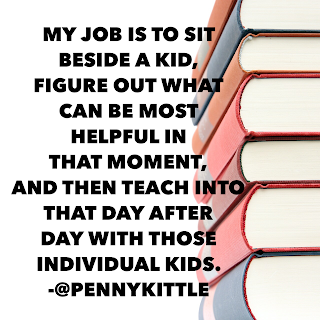This post has the purpose of celebrating the learning I did in my pajamas yesterday! OK, if I am being truthful, I was showered and being a mom while I learned. But, I could have been in my pajamas. The Educator Collaborative, under the direction of +Christopher Lehman, held their Fall #TheEdCollabGathering online yesterday. They had 4 sessions over the course of Saturday, with 18 workshop choices and 2 keynotes. I was able to attend most sessions live, thanks to a rain out of a soccer game, but they are all archived online too! Here is the link:
https://gathering.theeducatorcollaborative.com
The opening Keynote was by Penny Kittle. Wow. I really wish I could go back to school and be in her classroom. She is simply amazing. She said a bunch of awe inspiring things, but the quote above was the huge take away for me. She talked about giving the students time to read, and getting them to have momentum while reading, and using Book Talks to gain some momentum. But when she said that her job is to sit down with individual readers and teach them were they need to be taught, it really hit home. There are so many things that teachers do, and somehow reading with kids seems to get bumped off our to-do lists. As a coach, people always tell me that they don't have time to conference with students. But, as she sees it, that is our JOB. I need to help them find the time to confer!
The session by Franki Sibberson was actually about using technology in a reading workshop. This topic interests me, as our district is 1:1, and I am actually leading a session at the Illinois Reading Council conference in a few weeks about literacy and technology. She had many wonderful things to say, but the idea of "intentionality" that she weaved throughout was my biggest take away. I am constantly talking to teachers about being responsive, and making choices that are relevant to the needs of their students. We can't be intentional if all the choices are made for us. It matters that teachers can weigh their options, either with tech programs or instructional delivery, and that they can decide which will make the difference for their students. It matters, as well, that our students are faced with choices. If they never have to weigh options and make decisions about their own learning goals, they can't learn to be intentional, either.
I would talk about my learning from Jennifer Serravallo's session, but to be honest I want to watch the archive a few more times and make a blog post about her new book all by itself. So, I will. Every time I listen to her speak, I find a new way to organize my brain a bit more around literacy. She is amazing.
The closing keynote was by Kristine Mraz and Christine Hertz. They recently wrote a book (pictured below) that talks about how to create a mindset for learning in our classrooms. They described the kind of classrooms that would create better humans for the world of tomorrow. They think that by teaching empathy, optimism, persistence, resilience, and flexibility, we can actually show our students what it means to have self-control and be in control of their own learning. They have the goal of building community, not compliance, in their classrooms. They know that students don't always come to us with the independent skills that they need to be successful, and that it is our job as teachers to help mentor them into those skills. As a mom, and as a teacher, my thoughts exactly!!!
I happen to believe them 100%. I always felt that my relationship with my students was the single most important thing that I could give them, because not all my students develop at the same pace. If I know them, and I myself have the same empathy and optimism and flexibility that I ask them to have, we almost always came to a place where we were both successful.
I need this book. :)
I went to a few more sessions, but it is beautiful out and the park is calling my family. So, here are just a few more people from yesterday that I would add to the people you follow on Twitter. Your PLN will thank you!
@ichrislehman
@JSerravallo
@KristinZiemke
@MrazKristine
@christine_hertz
@MrBronke
@kimyaris
@frankisibberson
@pennykittle























